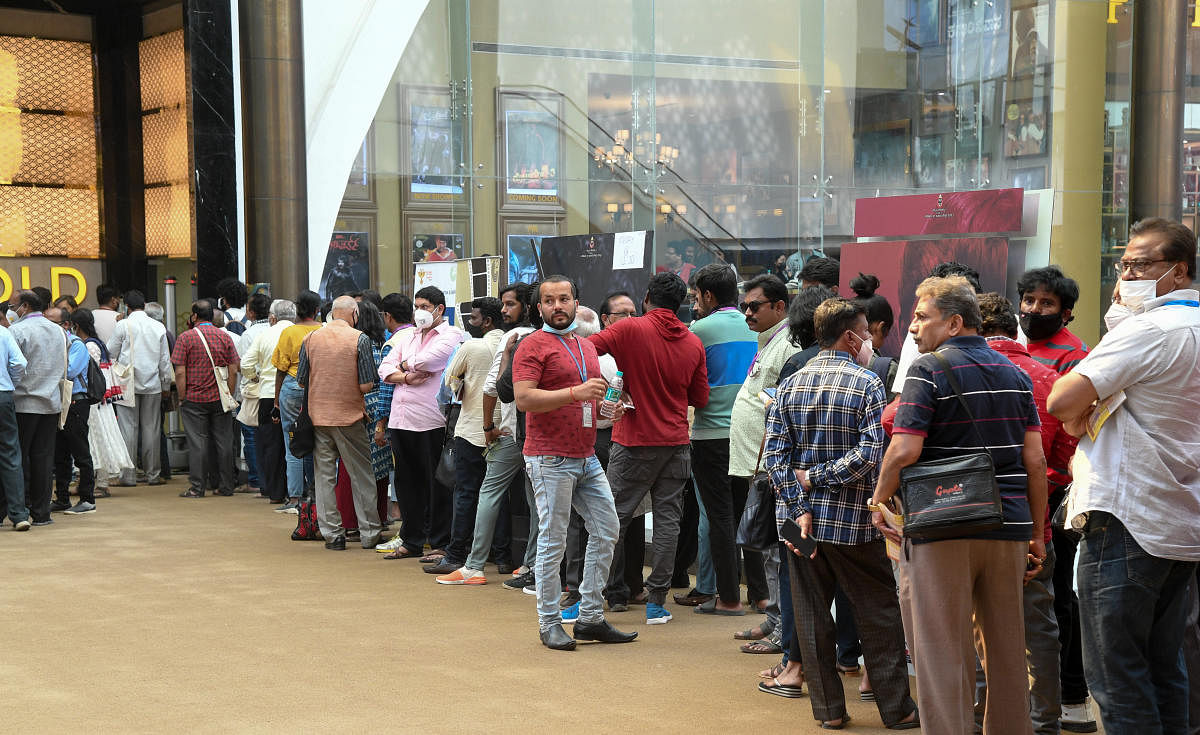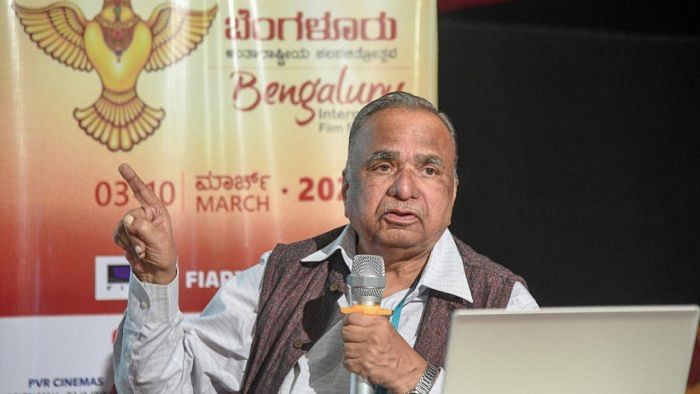

Long queues outside the screening of ‘Bad Roads’ at a mall in Bengaluru last week was proof that the draw of a film festival lies in the movies it curates. Natalya Vorozhbit’s 2020 film reflects on the hostile relations between Russia and Ukraine, which have now turned into a war and a humanitarian crisis with global consequences.
It proved to be a timely film at the recently-concluded Bengaluru International Film Festival (BIFFes), chosen by curators and jury members who had just two months to watch, critique and prepare a catalogue of 250 films from the initial stock of very many.
The menu of 54 films under ‘Cinema of the World’ — the most sought-after category in any film fest — made up for the blips that marked the hurriedly-organised event. The government promised 100 per cent occupancy and gave a nod to the event at the 11th hour!
However, the selection of regional films failed to impress.
The success of a film festival depends on the period between the initial curation and the final selection. So the curators of BIFFes took me back in time to a month ago when they got down to the job.
‘Curation takes 6-8 months, we had only 2 months to pull it off’
I interrupted Kannada film director P Sheshadri’s lunch to understand the process of curating a festival that’s open to stalwarts, film aspirants and hobby watchers. How do you please them all?
“It usually takes six-eight months to curate the films,” Sheshadri, also the chief festival coordinator, drew the comparison with the terribly short deadline they were given. “Since this edition battled the uncertainties (over the Omicron scare), we started curating for ‘Cinema of the World’, a non-competition category, only from the last week of December,” he said.
Cinema buffs and experienced critics were consulted to form an internal team to curate. Then began the watch-a-thon. “Each film has to get a clearance from the censor board. We have to watch all the films to be able to answer any questions the board may raise. I would watch as many as five films a day,” he recalled.
“In Karnataka, we are in great need of a Directorate of Film Festivals. The body works throughout the year, following and contacting agents of the films that do well in reputed festivals at Cannes, Busan and Berlin,” he talks of the disadvantage they had to work around.
When I met H N Narahari Rao, a veteran historian and artistic director of BIFFes, he told me at least four months are needed to curate the films. On the opening day, he even asked Chief Minister Basavaraj Bommai to give them more time in the future.
“But it helped that I had a great team. We need to cater to all kinds of people and not just serious cinema lovers,” he shared while talking about the process of curation.
Sourcing and bargaining
Narahari says, “We check on the availability of international films through distributors. It takes 15-20 email interactions with the distribution agency to procure one film. Since they are also in the business of films, we receive a response in 30 minutes.”
Then begins the bargaining. “A big film quotes about 1,000 euros (approx Rs 85,000). Since we keep an eye on different festivals and the pricing of every film, we try to bring it down to 300-400 euros (Rs 25,000-Rs 33,000). It requires a lot of time,” he explained.
Not all negotiations come through. The team, Sheshadri said, failed to acquire 2020 Chinese drama ‘One Second’, a critically-acclaimed film about a man who escapes from a farm-prison, which they very keen on. “The agents did not lower the prices to meet our budget,” he informed. They had an upper hand on some fronts. Bengaluru has many cultural exchange centres. So Alliance Francaise de Bangalore helped them source French films for the ‘Country Focus’ category, and Max Muller Bhavan, a cultural institute of Germany, arranged a retrospective of German legend Volker Schlondorff.
Plan in advance
Thanks to a chance conversation with Harish Mallya, consultant curator of the festival, I learnt that curation can sometimes begin as early as a year in advance. “For example, ‘Klondike’ is a 2022 film about a Ukrainian family living on the border with Russia during the start of the war. It is a highly relevant film today and my job is to try and get the movie for the festival next year,” he says.
Jury process: Reluctance, upset, politics
My chat with eminent director P Sheshadri at BIFFes was interrupted by a filmmaker from Kerala.
“Sir, you were recently a part of the jury at the Kerala Film Festival when my film was shown,” he reminded Sheshadri. “Yes. It was interesting but unfortunately, we couldn’t select it,” Sheshadri said. “That’s alright, sir. My film got banned in Kerala after that, for five years,” said the filmmaker with a smile so self-assured of his work.
That brief exchange gave me a peek into the onerous responsibility the jury has and the criticism their decisions can attract. It’s a draining job divided between selecting films for screening and choosing winners.
Sheshadri began, “We got 82 entries in the Kannada section this year. If a jury member in the preliminary panel had to watch all of them, he would need 25 days. Since we were short on time, we made two panels of seven and five members each.”
But constituting a jury panel is easier said than done. “People are afraid to become jurors because it can affect their rapport with filmmakers. Sometimes, people could be connected to the film, so they stay away because of the conflict of interest,” he said.
Things can get sour at any point though. “If good films get rejected for obvious reasons like they don’t match the festival guidelines, it can affect the relationship between the jury member and the filmmaker. There are reasons for every rejection which we can’t disclose,” he explained.
The vetting process must be cognisant of the social realities. “In most Indian film festivals, three things are considered: aesthetic value, artistic value, and social content because of the diversity of the country. The films shouldn’t insult the religious sentiments of people and they must encourage unity and integrity,” he explained.
But some directors don’t take the rejection personally. Such as Sajin Babu, whose controversial Malayalam film ‘Biriyaani’ on a Muslim woman was first rejected by the film festival of Kerala and picked up later.
“I didn’t object because I knew the film is politically strong and some jury members would have found it hard to take up. Also, festival recognition is not the ultimate,” he said. However, this time, the roles reversed at BIFFes as he came in as the jury.
Burnout?
Do they experience burnout from watching films back to back? How do they survive bad films and return to watch another title with the same vigour? What about working alongside a jury member you don’t get along with? I wanted to know because one bad movie and I start cursing my job!
“I watched 68 films in 12 days. That’s at least five movies per day. I didn’t find it challenging. When I was an aspiring filmmaker, I watched six films a day at the International Film Festival of Kerala (IFFK). Even otherwise, I watch 2-3 FDFS (First Day First Show) of commercial releases,” said Sajin.
“I don’t put pressure on myself because a juror’s opinion is subjective. My observations need not be the same as my colleagues’. We met and discussed before giving the final verdict,” he said and went on to reveal that some filmmakers in the past have unfriended him on Facebook because he didn’t pick their films.
He said one needs to keep friendship, personal agenda and politics aside for this job. “You have to always be in the right mood while watching the films. You can’t fast-forward or quit mid-way,” he added.
Politics and economics
As I broached the topic of politics in selecting films with a filmmaker, he asked me to talk in hushed tones and agreed to speak in condition of anonymity.
The omission of ‘Pedro’, a Kannada film about an outcast who accidentally kills a cow, from BIFFes had stirred up a row. The film has been winning praises in the global circuit but did not even qualify here.
“Films that are cinematically-superior and thought-provoking need not be politically correct. But politics (of the country and the state) plays a big role in selecting films for the competition category,” he said and went on to add, “A pro-Hindu film isn’t encouraged at Kerala’s film festival but a pro-left movie is. In Karnataka, it’s the reverse. In Delhi, the ideology of the ruling party is promoted.”
Many films at BIFFes were issue-based, depicting the victory of the righteous. “That doesn’t make for good cinema,” he rued.
The inclusion of mainstream films like Kannada ‘Kotigobba 3’ and Tamil ‘Soorarai Pottru’ was panned by festival goers, who came looking for ‘rare gems’. “The directors of massy films don’t get the respect for their craft just because they make massy films. So it’s important to bring their films here for critical appreciation,” he defended. Not to forget, it is the mainstream movies that bring money to the film industry, he added.
Watch latest videos by DH here: